In 1912, in The Theory of Pawn Promotion, Alain White wrote that
he had 'never heard of a game where victory was won by a promotion to Rook
or Bishop'. In 1936 the great endgame connoisseur Harold Lommer wrote something
to that effect too. In my own Chess Curiosities (1985) I mentioned
the 'extreme rareness of such promotions', and quoted 12 examples from
all of chess history, including trivial ones. Ten years later Harold van
der Heijden, in his Pawn Promotion, extended the list to 27. We
had entered the database era - he had used a 400,000 game one. Over the
following two years, in the magazine EBUR, he showed some 15 new cases.
My turn again - in the meantime the databases have grown to almost 2,000,000
games, and if I used the same criteria as in 1985, I could show over 60
examples now.
It's beginning to spoil the fun. We shouldn't know
that much. Sometimes, letting my computer hunt in the databases, I feel
like a peeping Tom of chess history - as if I were reading a loved one's
secret diary.
But even now, Alain White's 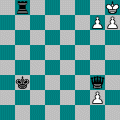 question
pops up in the newsgroups: has ever a game been won by a promotion to Rook
or Bishop? Why, yes - maybe it's time to rephrase his remark: has ever
a game been drawn by a promotion to Rook or Bishop? Not that I know
of, but it could happen - it doesn't take more than 5 minutes to set up
a crude idea that might occur in a game. In the diagram on the left, White
must promote. 1.g8N and g8R allow Qe5 mate, and 1.g8Q+ K- 2.Qxb8 Qxb8+
is a simple win for Black. But after 1.g8B+ Black must make a King
move and White is stalemate.
question
pops up in the newsgroups: has ever a game been won by a promotion to Rook
or Bishop? Why, yes - maybe it's time to rephrase his remark: has ever
a game been drawn by a promotion to Rook or Bishop? Not that I know
of, but it could happen - it doesn't take more than 5 minutes to set up
a crude idea that might occur in a game. In the diagram on the left, White
must promote. 1.g8N and g8R allow Qe5 mate, and 1.g8Q+ K- 2.Qxb8 Qxb8+
is a simple win for Black. But after 1.g8B+ Black must make a King
move and White is stalemate.
Or take the following two examples from endgame
studies. Neither are the initial positions; I just want to show the ideas,
which are imaginable in games.
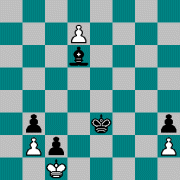
White to play F. Lazard, 1935 1.d8R! If 1.d8Q, then Bf4 2.Qd2+ Kf3 3.Qxf4+ Kxf4 and Black wins.
1...Bf4 (Bxh2 2.Rd3+!) 2.Rd2 and Black's King cannot move
without causing stalemate, e.g. 2...Bg5 3.Rd5 Kf4 4.Rd2 Bh6 5.Rd6 Kg5
6.Rd2 etc.
|
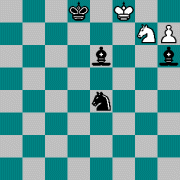
White to play V. Vlasenko, 1967 If 1.h8Q, then Nf6 or Nc5 followed by Nd7 mate. And if 1.h8N Ng5! 2.Nf7+ Nxf7 and Black wins. But: 1.h8B! A brilliant idea: self-paralysis. If now Nf6 or Nc5, it is stalemate. And after moves that relieve the bind, a drawn endgame of 2 minor pieces vs. 3 remains. PS 14 January 2000: As reader Gerhard Josten informs me, the tablebases say Black is winning after 1...Bg4 - and that therefore this study is incorrect. A pity for the beautiful idea. |
IN THE DATABASES TODAY, a few hundred games with Rook and Bishop promotions can be found, but the majority are silly jokes. Sometimes an underpromotion is used to remind the opponent that it's time to resign. Often he does. Sometimes players, especially young amateurs (but even Topalov has done it in a tournament game against Kramnik), will promote to Rook or Bishop when that new piece has to be captured anyway.
There
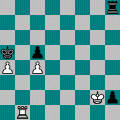 are
also joke promotions that, without having anything to do with stalemate,
still have some practical significance; when the choice between capturing
the new piece and not capturing it is not obvious. An example is Salnikov
- Bezgodov, Pavlodar 1991 (left), where Black played 61...h1B+
Had he played h1Q+ or h1R, White would have had to capture, but now he
had to think. A ploy like that, to confuse the opponent, might be useful
in time trouble. White did not take the Bishop (the pawn endgame is dead
lost) but after 62.Kf2 Bc6 Black won in a few moves anyway.
are
also joke promotions that, without having anything to do with stalemate,
still have some practical significance; when the choice between capturing
the new piece and not capturing it is not obvious. An example is Salnikov
- Bezgodov, Pavlodar 1991 (left), where Black played 61...h1B+
Had he played h1Q+ or h1R, White would have had to capture, but now he
had to think. A ploy like that, to confuse the opponent, might be useful
in time trouble. White did not take the Bishop (the pawn endgame is dead
lost) but after 62.Kf2 Bc6 Black won in a few moves anyway.
Bordering
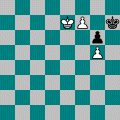
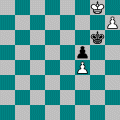 on
silliness, or even rudeness, are those underpromotions where the only point
is that an immediate promotion to Queen would have been stalemate. A case
in point is Ruben - Sultan Khan, Hamburg 1930, (diagram on the left)
where Black resigned after 74.f8R, but 74.Kf6 would have been mate
in 3. Varga - Ivanka, Hungary 1991 (diagram on the right) is special
in that of White's six legal moves, only the promotions to R, B and N are
winning. He chose 63.h8R, and Black resigned.
on
silliness, or even rudeness, are those underpromotions where the only point
is that an immediate promotion to Queen would have been stalemate. A case
in point is Ruben - Sultan Khan, Hamburg 1930, (diagram on the left)
where Black resigned after 74.f8R, but 74.Kf6 would have been mate
in 3. Varga - Ivanka, Hungary 1991 (diagram on the right) is special
in that of White's six legal moves, only the promotions to R, B and N are
winning. He chose 63.h8R, and Black resigned.
But
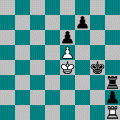 even
when an underpromotion is the only move, it can still be a silly joke -
by the opponent. In Vasiukov - Tukmakov, Erevan 1976 (diagram on
the left) White, as a way of admitting he was lost, played 59.Rg1+,
and resigned after hxg1R. This sort of thing, where one side invites
promotion and the only finesse is that promotion to Queen is stalemate,
happens quite often, and my sharpened criterion does not include them anymore.
even
when an underpromotion is the only move, it can still be a silly joke -
by the opponent. In Vasiukov - Tukmakov, Erevan 1976 (diagram on
the left) White, as a way of admitting he was lost, played 59.Rg1+,
and resigned after hxg1R. This sort of thing, where one side invites
promotion and the only finesse is that promotion to Queen is stalemate,
happens quite often, and my sharpened criterion does not include them anymore.
The distinction between the silly and the serious is not completely clear. What to make of
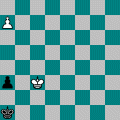 Amelung
- Erler, Katharina 1893 (diagram on the right)? That position must
have happened more often, but probably no one ever thought of what Amelung,
an endgame composer, played here. He announced mate in 3 beginning with
1.a8R. Against 1...Ka2 or a2 a promotion to Queen would have worked
as well (2.Kc2 and various Queen moves respectively), but 1...Kb1 2.Qxa3
is stalemate. With a Rook, Rxa3 is then possible, and it is mate next move.
And in fact, this position, perfectly mirrored, had already appeared as
a 'Mate in 3' by A. Barbe, in 1861.
Amelung
- Erler, Katharina 1893 (diagram on the right)? That position must
have happened more often, but probably no one ever thought of what Amelung,
an endgame composer, played here. He announced mate in 3 beginning with
1.a8R. Against 1...Ka2 or a2 a promotion to Queen would have worked
as well (2.Kc2 and various Queen moves respectively), but 1...Kb1 2.Qxa3
is stalemate. With a Rook, Rxa3 is then possible, and it is mate next move.
And in fact, this position, perfectly mirrored, had already appeared as
a 'Mate in 3' by A. Barbe, in 1861.
Coming to serious practical underpromotions - over half of them have the same configuration, the one we already saw in
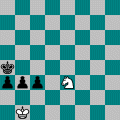 Ruben
- Sultan Khan: Black's King is at h7, g6 is inaccessible, and White cannot
promote to Queen on f8 because that would be stalemate. (And all mirror
situations.) The simplest possible case is also the oldest.
Ruben
- Sultan Khan: Black's King is at h7, g6 is inaccessible, and White cannot
promote to Queen on f8 because that would be stalemate. (And all mirror
situations.) The simplest possible case is also the oldest.
In Von Guretzky Cornitz - Neumann, Berlin 1863 (diagram on the left), there followed 1...c2+ (a2+ works the same way) 2.Nxc2 a2+ 3.Kb2 bxc2 4.Kxa2 and now Black played the only move c1R, and White resigned.
Equally trivial cases, in all of which there were other moves to win are shown in the 5 diagrams below:
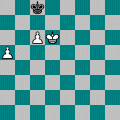
Black to play Simonson - Em.Lasker New York sim 1892 |
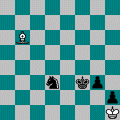
Black to play Alapin - Rubinstein Vienna 1908 |
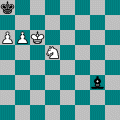
White to play Jansen - De Greef Dieren 1990 |
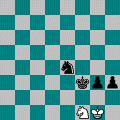
White to play Makogonov - Dubinin USSR 1940 |
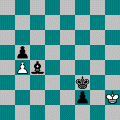
Black to play Jordan-West Australia 1980 |
Just a trifle less trivial were:
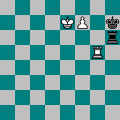
White to play Steiner - Morton USA 1936 |
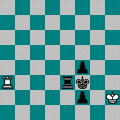
White to play Roehrl - Wittmann Austria 1981 |
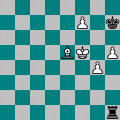
White to play Flores - Letelier Santiago 1959 |
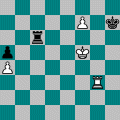
White to play Malishauskas-Donchenko USSR 1988 |
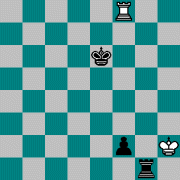
Another theme with this configuration, and which is sometimes used
in endgame studies, was first seen in Badestein - Otto, Wernigerode
1952 (diagram on the left.) After 66...f1R White resigned; f1Q?
and White has a 'Rambling Rook' which will check forever along the 8th
rank.
In contrast, in all of the following examples promotion
to Queen would also have worked. But sometimes it would have been tricky,
and in most cases the Rook promotion was the most sensible and practical
thing to do: why think if you don't have to.
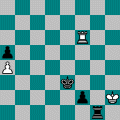
Black to play Rajna - Lengyel Budapest 1982 |
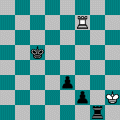
Black to play Jacobowitz - Grosse Dresden 1993 |
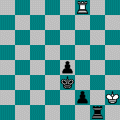
Black to play Wolf - Hartmann Germany 1991 |
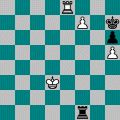
White to play Istratescu - Bancod Biel 1993 |
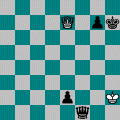
Black to play Dehmelt - Fedorowicz Reykjavik 1986 |
THERE IS EVEN an elementary endgame that (although grandmasters normally do not play it to the end) must have
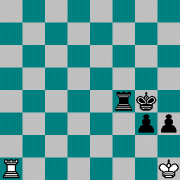 happened
thousands of times, and in which White can sometimes force the win with
a promotion to Bishop, and sometimes to Rook; the endgame of Rook + h-
and g- (or a- and b-) pawns vs. Rook.
happened
thousands of times, and in which White can sometimes force the win with
a promotion to Bishop, and sometimes to Rook; the endgame of Rook + h-
and g- (or a- and b-) pawns vs. Rook.
If the weaker side keeps his King in the corner, as in Dawidow - Czerwonski, Krynica 1997 (diagram to the left), the procedure given by Euwe in his standard work on the endgame is h2 followed by Kh3 (Kg2 Rf2+). One can also begin with g2+ (see below) but it is more fun to add, apart from the Bishop promotion, a little Rook sacrifice: 75...Rf1+ 76.Rxf1 g2+ 77.Kh2 (77.Kg1 Kg3) gxf1B and White resigned. (Of course a Knight promotion would work here too.)
It is remarkable that in neither of the following four examples, the opportunity of the Rook sacrifice was used.
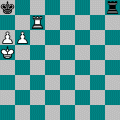
White to play Beni - Littlewood Lucerne 1963 |
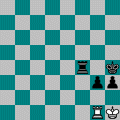
Black to play Schichtel - Abend Germany 1987 |
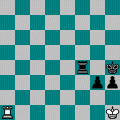
Black to play Apicella - Bellia Vinkovci 1989 |
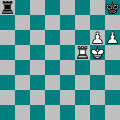
White to play Kreiman - Salman Philadelphia 1992 |
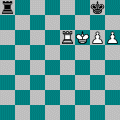
Black to play Lacroix - Bolzoni Brussels 1986 |
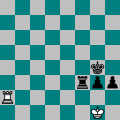
Black to play Fallone - Vranesic Havana ol 1966 |
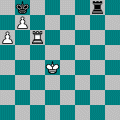
White to play Wicker - Way Copenhagen 1987 |
In another recurring configuration the Black King is on h6, h5 is guarded, and the promotion is on g8 (and mirrors.)
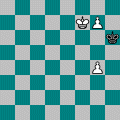
White to play Sajtar - Benko Budapest 1954 |
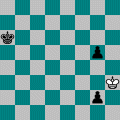
Black to play Garcia - Bellon Torre Grande 1990 |
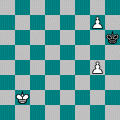
White to play Torre - Gufeld Kuala Lumpur 1994 |
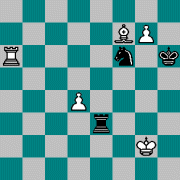
White to play Stahlberg - Czerniak Buenos Aires 1941 |
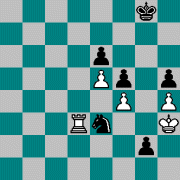
Black to play Chan - Depasquale Laoag 1985 |
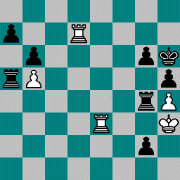
Black to play Serper - Navrotescu Oakham 1988 |
We come to more diverse cases. In ascending degree of interest:
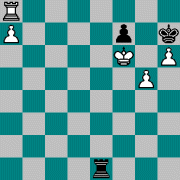
Black to play Pinzon - Del Pozo Lima 1959 |
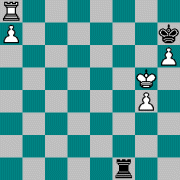
Black to play Grishchuk - Hua Szeged 1994 |
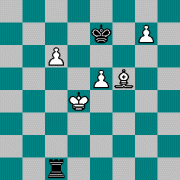
White to play |
Gluzman - Sabic
Sydney 1992 Black had already played on for too long. Not even 91.g8R made
this clear; after Rxc6 he played on seven more moves. 91.g8Q was
possible; 91...Rd1+ 92.Kc5 and already the good checks are over.
|
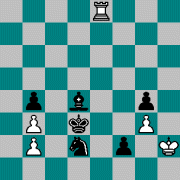
Black to play |
Ashley - Bezold Bermuda 1997 Just about every legal move would win here, and I would have expressed
my dismay over White's for playing on with simply 74...f1Q 75.Re3+ Kc2
76.Rc3+ bxc3 and mate next move. Black chose 74...f1R and White
resigned.
|
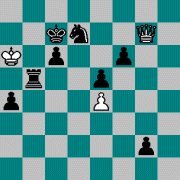
Black to play |
Ahlander - Krasenkov
White resigned after 50...g1R; 50...g1Q 51.Qxd7+ would have been stalemate.
|
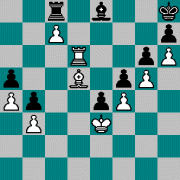
White to play |
Tomic - Winzbeck
White decided the game with the nice little trick 43.Rd8 Rxd8 44.cxd8B and Black resigned.
|
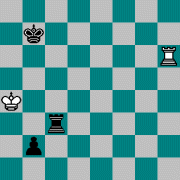
Black to play |
Nedela - Schmaltz
Stockerau 1992 After 54...b1R (54...b1Q? 55.Rb6+ is a draw) White resigned,
but 54...Rc4+ and 55...b1Q would have won more easily; Rh7+ is met by Rc7.
|
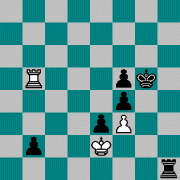
Black to play |
Weitthoff - Maki
USA 1988 58...b1R and White resigned two moves later; 58...b1Q 59.Rxf5+
would have been a draw.
|
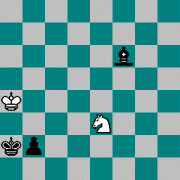
White to play |
Boniface - Pugh
Bristol 1995 A study-like intermezzo: after 63.Nd1, Black had to play 63...b1B,
because 63...b1Q or b1R 64.Nc3+ Bxc3 would be stalemate. Although the position
was then technically won for Black, he did not manage to win, and a draw
was agreed at move 92.
|
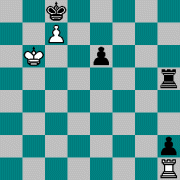
White to play |
Kholmov - Ehlvest
Wolgodonsk 1983 After 72.Ra1, there followed h1B! (72...h1Q
73.Ra8+ Qxa8 would have been stalemate). Now it was easy; after 73.Rf1
Rh8 74.Rf7 Re8 75.Kc5 e5 76.Kd6 Bb7 White resigned.
|
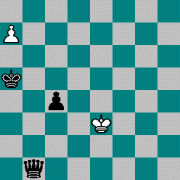
White to play |
Bremel - Kertis
Budapest 1948 Again a finish that is doubtless also the finish of some endgame studies.
1.a8R+! and Black (probably; I do not have the score of the whole
game) resigned. 1.a8Q+ would have been stalemate after Kb4 2.Qb7+ Kc3 3.Qxb1
|
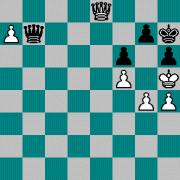
White to play |
Reshko - Kaminsky
Leningrad 1972 61.a8Q (or a8R) Qf7+ 62.Qxf7 would be stalemate. After 61.a8N Qa7 it is very hard to see how White can make progress. What else? 61.Qb8 or 61.g5 allow mate in 1. But 61.a8B, which White played, is a fairly easy win. There followed: 61...Qb3 62.Qd7 Qg8 63.Bd5 Qf8 64.Bf7 Kh8 65.Qe8 Qxe8 66.Bxe8 Kh7 67.Bf7 Kh8 68.Kg6 h5 69.Kxh5 Kh7 70.Be8 Kg8 71.Kg6 and Black resigned. |
Let's first look at some other tries.
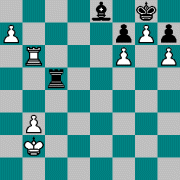
White to play |
Or 1.Rb8 Rc2+ (Rc8? 2.Ka3! and Black is in zugzwang: 2...Rd8 3.a8Q Rxb8 4.Qe4 winning or 2...Rxb8 3.axb8N! and Black gets mated) 2.Ka3 Ra2+ 3.Kb4 Ra4+ 4.Kc5 Ra5+ 5.Kd6 Ra6+ 6.Ke7 Rxa7+ 7.Kd8 Rd7+ 8.Kc8 Rc7+ 9.Kd8 Rd7+ 10.Kxe8 Rd8+ and draw.
A good try seems 1.a8N because the Knight could be negotiated to e7 to give a deadly check, but again Black uses the immured stalemate position of his King: 1...Rc8! 2.Ra6 (2.Nc7 Rxc7 3.Rb8 Rc2+) Rxa8 3.Rxa8 stalemate.
Vacating b6 for a future Knight, for example with 1.Rb7, is refuted by Rc8 and there will be no Knight.
All Black has to watch out for in these variations is the zugzwang mentioned above, e.g. 1.Rb4 Rc8 2.Rb7 Ra8?? 3.Rb8 Rxb8 4.axb8=N and mate. But this is easily avoided.
Well then, 1.a8B. For a long time, the only analysis I saw on this position was in my own book in Dutch, Schaakkuriosa (1974), where it says Black now draws by chasing the Bishop: 1...Rc8 2.Be4 Bc6 3.Bb1 (the winning chances after 3.Bxh7+ are illusory) Be4 4.Ba2 Bb1! and the Rook will have its perpetual.
But the Dutch master and endgame composer, Cortlever, refuted this strange Bishop chase.
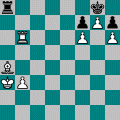
White to play |
The question remains as to how White wins if Black does not chase the Bishop. We return to the position after l.a8=B (see diagram).
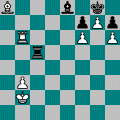
Black to play |
(a) 1...Rh5 2.Be4 Rxh6 3.Ka3 (zugzwang; but 3.Rb8 Rxf6 4.Rxe8+ etc. may also win) Rh5 4.Rb8 Re5 5.Bc6 etc. (Cortlever)
(b) 1...Rc7 Black tries to maintain the seventh rank. 2.Bd5 Bd7 (2 ...Rd7 3.Rb8 Rd8 4.Bxf7+) 3.Rd6 and Black is paralysed; if 3...Rc- 4.Bxf7+, and if 3...Be8 4.Bxf7+ Kxf7 5.Rd8 (this would also have followed after other captures), and Black has no defense against 6.Rxe8 and/or g8Q+.
(c) 1... Rc8 2.Bd5 Knowing, by Cortlever's proof, that it doesn't have to let itself be chased, the Bishop chooses the best square. 2...Rd8 (2... Rc- 3.Bxf7+ etc.; 2...Bb5 or Ba4 3.Bxf7+; 2...Bd7 3.Rb7 threatening 4.Bxf7+; now 3...Rd8 4.Bc4 Be8 5.Re7 as well as 3...Be8 4.Re7 lead into the main variation) 3.Bc4 Rc8 (Black must keep to the eighth rank, e. g. 3...Rd2 + 4.Kc3 Rf2 5.Bxf7+ Kxf7 6.Re6 Rg2 7.Re7+ etc.; or 3...Bd7 4.Rd6 Be8 or R- 5.Bxf7+) 4.Rb7 Rd8 (4...Rc- 5.Bxf7+) 5.Re7 and now Black can only play his Rook on the eighth rank where it will be collected by the white King, e.g. 5...Rc8 6.Ka3 Rb8 7.Bd5 Rd8 8.Kb4 Rb8+ 9.Ka5 Rd8 10.Kb6 Rc8 11.Kb7 Rd8 12.Kc7 Rd7+ 13.Rxd7 Bxd7 14.Bxf7+ etc.
(d) 1...Re5 Preventing the strong move Bd5. Some very queer possibilities now arise.
(d1) 2.Rd6(?) Bc6! 3.Rd8+ (3.Bb7 Re8! 4.Ba6 Bb5 5.Bc8 Bd7 draw) 3...Be8! (3...Re8 4.Rxe8+ Bxe8 5.Be4 Bc6 6.Bxh7+ and White wins) 4.Rd2 Bc6 5.Bb7 Re8 6.Ba6 Bb5 7.Bxb5 Re2 draw.
(d2) 2.Bf3! and now the Bishop will reach the vital c4-f7 diagonal without Black obtaining his perpetual; e.g. 2...Bc6 3.Bd5! or 2...Bb5 3.Bd5! or 2...Rf5 3.Be4 (3.Rb8 Re5) 3... Re5 4.Bd3 Bb5 5.Bc4 and White wins by bringing his Rook to e7 (5... Re8 or Bc6 6.Bxf7+).
In summary: 66.a8=B is winning, and is White's only winning move in
Sokolsky - Ravinsky.
IN CHESS CURIOSITIES, in 1985, I gave 12 examples of underpromotion
in games, of which 5 were 'above triviality as well as of uncontested authenticity.'
In this survey, I gave 47 examples, of which perhaps half could be called
interesting.
We're waiting for that drawing underpromotion now.
(c) Tim Krabbé 1999
With many thanks to Harold van der Heijden.
Comments and suggestions
Top of the page | Main
chess page | Main page